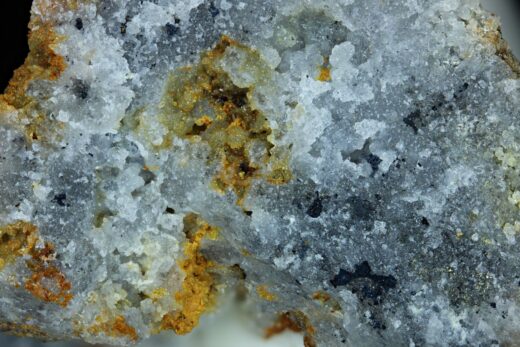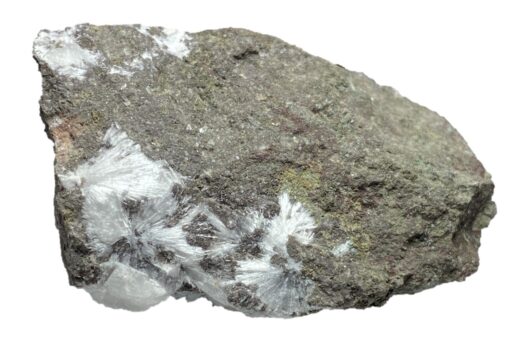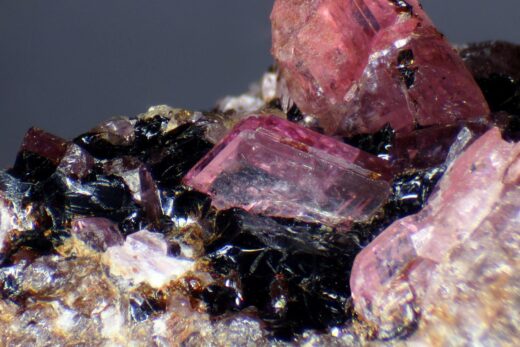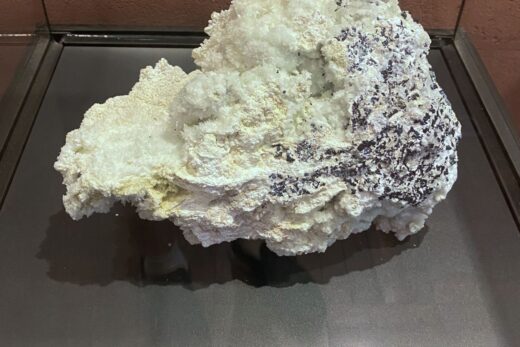Formula: Al2O3
From Alfredo Petrov:
CORUNDUM (kohgyoku; sei-gyoku)
- Ehime: Partly transparent (but not gemmy) pale pink to dark purplish red ruby crystals to 5cm diameter (often anhedral) occur in amphibole-zoisite rock of the Sanbagawa metamorphic belt in the Hodono valley. Fluorescent red in both LW and SW ultraviolet. The red colouration correlates to Cr oxide content, which ranges from 0.01 to 0.44 wt%. Associated with minor garnet, paragonite and chlorite.
- Fukushima: Greyish blue, platy hexagonal “sapphire” crystals to 7mm across occur in stream sediment derived from quartz pegmatite in the Ishikawa district. Blue grains are enclosed in large dark red andalusites (qv), and in muscovite rims around the andalusite, on the border of the quartz core zone of granite pegmatite at Kita-Sugama. Note that the corundum is never in direct contact with the quartz, being separated by the enclosing andalusite and muscovite. As granular aggregates with pale reddish andalusite in granitic pegmatite composed of orthoclase, quartz and muscovite, at Teshirogi. In non-schistose rocks of the Abukuma metamorphic belt at Kanougami, with staurolite, sillimanite, almandite, hercynite and monazite.
- Gifu: Pale blue to deep blue, tabular hexagonal xls to 7mm are found in a pneumatolytically altered, wolframite-cassiterite-bearing granite with muscovite, feldspar and black “protolithionite” mica at Yagenyama in the Naegi district. In cassiterite placers at Takayama, as prismatic grey crystals or sapphire-blue tabular crystals commonly 2 to 3mm across, generally with well-conserved edges, sometimes horizontally striated. Sometimes with light and dark blue banded colour zoning. Rough hexagonal crystals and crudely cylindrical spindles to 2cm diameter, zoned greyish blue to greyish violet or violet-pink or pink, some with graphite crystal inclusions, are found in graphite-bearing biotite schist and quartz gneiss in Kawai-mura, originating from mudstone metamorphosed by a diorite intrusion. The corundums are each surrounded by (or being altered to) a jacket of light to dark green, soft talc-like muscovite or pyrophyllite. Local collectors dig these out in some abundance from under tree roots and call them “rubies”, although no gem-grade material is present.
- Hiroshima: Blue to violet-blue small granular to very thin elongated corundum crystals to almost 2cm long are embedded in dickite in a “roseki”-type pyrophyllite deposit replacing a Cretaceous dacitic tuff breccia at Shohkohzan (also known as Sankin mine). Also here as opaque bluish masses and parallel stringers to 4cm, with diaspore in the pyrophyllite ore.
- Hyougo: Bluish grey translucent anhedral masses to 5cm, with paragonite at Kabozaka, in jadeite-bearing albitite.
- Iwate: Large crystals embedded in sillimanite hornfels at Okita. Analysis shows (wt% oxides) Fe”’ 1.82, Ti 0.31 (Hasegawa 1955; in DHZ 5).
- Nara: Blue transparent hexagonal platelets of sapphire to 2mm weather out of rock at Anamushi. Found with almandite and tiny zircons.
- Niigata: Japan’s largest corundum crystals, pale grey abraded crystals to well over 10cm, with rough rounded hexagonal cross-section, occur as river cobbles in old alluvium of the Hime river, where they are sometimes found during construction projects in Itoigawa city. Since these crystals are rather ugly and nondescript, they generally go unrecognized and may be more common than thought. Similar but smaller crystals are embedded in boulders in the Kotakigawa, from whence the Himekawa crystals may have washed down.
- Ouita: A component of fine-grained black emery vein at the Kiura emery (Shinkiura) mine.
- Toyama: Blue, spindle-shaped sapphires are abundant in dark grey graphite gneiss cobbles by “Yamamichi” (?????????????). Sapphire grains from 1 to 10mm are surrounded by white “eyes” of quartz and mica.
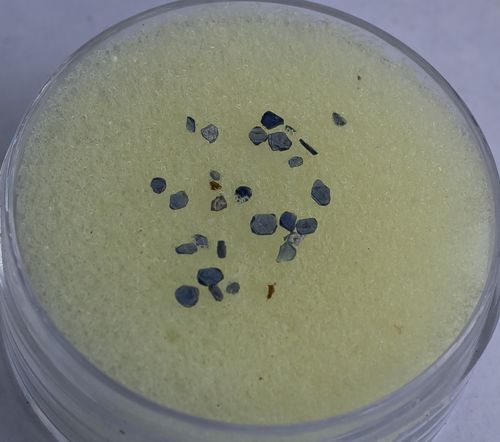
Above: About 20 1mm gem blue zoned sapphires from a placer deposit. Anamushi alluvials, Kashiba City, Nara Prefecture, Japan.
